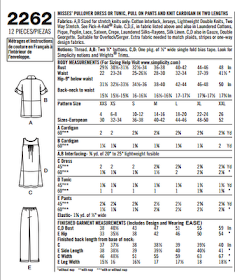 |
Getting your measurements
You're going to need to know your measurements going in. There's this handy guide to taking your body measurements, you'll want to have these written down somewhere before you go shopping, specifically your chest/bust, waist, and hip measurements, and then use the sizing chart on the back of the pattern to determine what version you need to look up.
If you're like me, you probably don't look like the model on the right, and you might find that your measurements don't quite line up right--your chest/bust line might be in one size, your waist in another, and then your hips in a third. For a simple sleeveless tunic, you basically want to size to either your chest or your waist, and then go with the larger size (If your chest is a L and your waist is a M, go with the L sizing). This isn't really a hard and fast rule, different patterns might require different allowances, and later on I hope to get into adjusting a pattern to fit your particular physique.
Finding your first pattern
For a beginning sewer, you want to find a pattern you like that is also simple and won't frustrate you with too many difficult steps. Later this month I'm going to do a step-by-step walkthrough of Simplicity pattern #2262 - View D. This is a simple sleevless tunic. This is a fairly basic pattern that will be an easy first try.
I highly recommend a sleeveless top or sundress for a first effort, even if you decide to go with a different pattern. There are lots of patterns out there that are "Fast and Easy" that still might be a little overwhelming for an absolute beginner.
Reading the back of a pattern
To get an idea of how complicated a pattern is, you'll want to check out the back. This is a Simplicity back, a Burda or McCalls pattern might be laid out slightly differently, but they will all have the same basic information and vocabulary. (Note: I'm using US measurements here, but most patterns will also have a European sizing section).
The left column is the fabric number, and all of the various pieces that you can make from the contents of he package. There is the cardigan (A & B -- A is the long and B is the short), the sundress (C) and tunic (D), and then the pants (E).
At the top of the main section is a list of fabrics that are suitable for each item. For example, the cardigan is sized for stretch-knits (like a jersey cotton) only, whereas the tunic and sundress can be made our of a woven material like cotton.
The next section shows you the Notions that are required for each item. Notions are things like thread, interfacing, buttons, zippers, etc. This is also where you can start to get an idea of how difficult the pattern might be. If you see a ton of notions on there: buttons, zippers, etc, this pattern might be a little advanced for a first effort. For this pattern, the notions are simple: thread and a package of single-fold bias tape. The bias tape is going to be how we finish the raw edges around the collar and sleeves, and won't be particularly difficult to execute.
Then there's the body measurement section, where you can compare the measurements you took before you left to determine what size you should be using. It's not a bad idea, after you purchase the pattern, to quickly circle the column for the pattern size you'll be making--this will help you get the right amount of fabric, etc. If you have concerns that the pattern might not fit, have a quick look down at the Finished Garment Measurements section, this will give you an idea if it will fit over your frame.
Between the Pattern Size and Finished Garment Measurements section is the fabric measurements section. There will often be 2 rows, as fabric can come in either 45" or 60" wide bolts. For example, for the C dress, if you are using 45" wide fabric, you need 2⅜ yards of 45" wide fabric, but if the fabric is 60" wide on the bolt, then you only need 1½ yards. Alternately, the A and B Cardigans are sized only for 60" fabric, and you won't be able to cut out the pattern on 45" fabric. If you're not sure if it's 45" or 60", ask the person at the fabric store, they will be able to tell you. Sometimes, fabric comes in 54" wide bolts. I would avoid using that for your first effort, or treat it like 45" fabric and expect to have a little more leftover.
Some patterns might require extra fabrics or notions, for example, the E Pants pattern requires elastic, and the A and B cardigans require interfacing. Some patterns might require a contrast color for things like belts, sleeves, or trim in addition to the main body of the clothing. Interfacing is not a difficult thing to use, and I'll go over how to use that pretty early, so don't shy away from a pattern that uses interfacing as a first effort. My first project had interfacing and I'm still alive today.
Next up: Buying fabric and getting it ready to turn into something you can wear! (other than a toga)

No comments:
Post a Comment